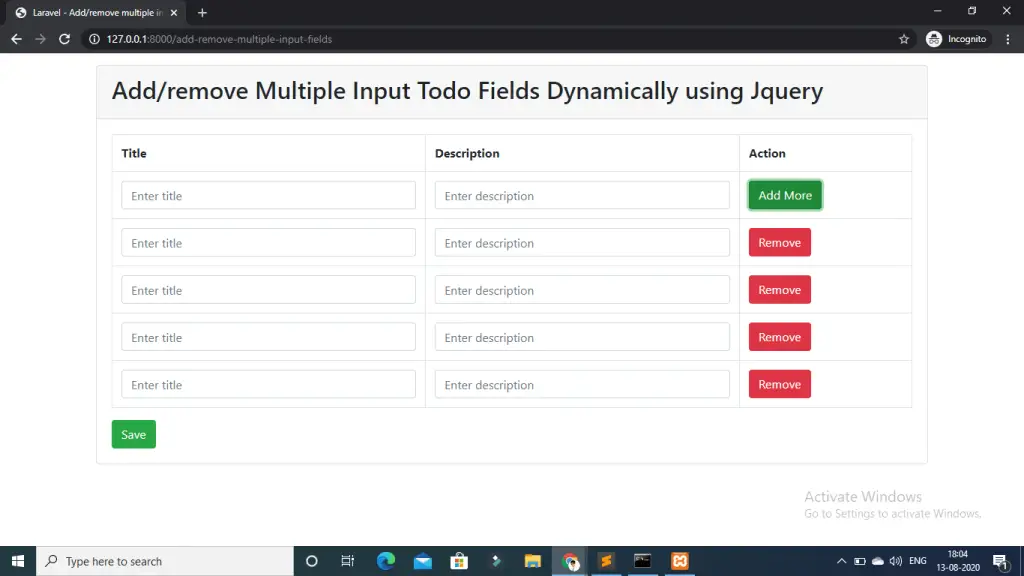To add and remove dynamically multiple input fields and submit to database with jquery and laravel; Simply create an input field on html form and use jquery .add() and .remove() function with this.
In this tutorial, You will learn how to dynamically add and remove multiple input fields and submit to MySQL database with jquery and laravel 10 apps.
Laravel 10 Add or Remove Multiple Input Fields Dynamically with jQuery
Steps to create dynamically add remove multiple input fields and submit to database with jquery and laravel:
Step 1: Create New Laravel 10 Project
First of all, open your terminal OR command prompt.
Then execute the following command into it to install or download laravel app for making dynamically add/remove multiple input fields and submit to database with jquery and Laravel 10 app:
cd xampp\htdocs Then composer create-project --prefer-dist laravel/laravel Blog
Step 2: Setup Database with Project
Once you have installed laravel project in your server. Now you need to setup database with project.
So, Navigate to your laravel project root directory and open .env file.
Then add your database details in .env file, as follow:
DB_CONNECTION=mysql DB_HOST=127.0.0.1 DB_PORT=3306 DB_DATABASE=here your database name here DB_USERNAME=here database username here DB_PASSWORD=here database password here
Step 3: Build Migration & Model
In this step, open again your terminal/command line/ command prompt. And execute the following command into it to create model and migration files for your laravel applications:
php artisan make:model Todo -m
This command will create one model name Todo.php and as well as one migration file for the Todos table.
Then Navigate to database/migrations folder and open create_todos_table.php. Then update the following code into create_todos_table.php:
public function up()
{
Schema::create('todos', function (Blueprint $table) {
$table->id();
$table->string('title');
$table->timestamps();
});
}
Then open Todo.php file and the fillable property, which is placed on app/models directory:
<?php
namespace App\Models;
use Illuminate\Database\Eloquent\Factories\HasFactory;
use Illuminate\Database\Eloquent\Model;
class Todo extends Model
{
use HasFactory;
protected $fillable = [
'title'
];
}
After that, run the following command to migrate the table into your select database:
php artisan migrate
Step 4: Define Routes
In this step, You need to define routes in web.php file.
So, Navigate to the app/routes directory and open web.php file. Then update the following routes into your web.php file:
use App\Http\Controllers\DynamicAddRemoveFieldController;
Route::get('add-remove-multiple-input-fields', [DynamicAddRemoveFieldController::class, 'index']);
Route::post('add-remove-multiple-input-fields', [DynamicAddRemoveFieldController::class, 'store']);
Step 5: Create Controller by Artisan
In this step, open your terminal or cmd and run the following command to create controller file:
php artisan make:controller DynamicAddRemoveFieldController
This command will create a controller named DynamicAddRemoveFieldController.php file.
Next, Navigate to app/http/controllers/ folder and open DynamicAddRemoveFieldController.php. Then add the following file uploading methods into your DynamicAddRemoveFieldController.php file:
<?php
namespace App\Http\Controllers;
use Illuminate\Http\Request;
use App\Models\Todo;
use Illuminate\Support\Facades\Validator;
class DynamicAddRemoveFieldController extends Controller
{
public function index()
{
return view("add-remove-input-fields");
}
public function store(Request $request)
{
$request->validate([
'moreFields.*.title' => 'required'
]);
foreach ($request->moreFields as $key => $value) {
Todo::create($value);
}
return back()->with('success', 'Todos Has Been Created Successfully.');
}
}
Step 6: Create Blade View
In this step, create one blade view file named add-remove-multiple-input-fields.blade.php.
Now, navigate resources/views and create one file name add-remove-multiple-input-fields.blade.php Then update the following code into your add-remove-multiple-input-fields.blade.php file:
<!DOCTYPE html>
<html>
<head>
<title>Laravel 10 - Add/remove multiple input fields dynamically using Jquery</title>
<link rel="stylesheet" href="https://stackpath.bootstrapcdn.com/bootstrap/4.5.1/css/bootstrap.min.css">
<script src="https://code.jquery.com/jquery-3.5.1.min.js"></script>
<script src="https://stackpath.bootstrapcdn.com/bootstrap/4.5.1/js/bootstrap.min.js"></script>
<meta name="csrf-token" content="{{ csrf_token() }}">
</head>
<body>
<div class="container">
<div class="card mt-3">
<div class="card-header"><h2>Add/remove Multiple Input Todo Fields Dynamically using Jquery In Laravel 10</h2></div>
<div class="card-body">
<form action="{{ url('add-remove-multiple-input-fields') }}" method="POST">
@csrf
@if ($errors->any())
<div class="alert alert-danger">
<ul>
@foreach ($errors->all() as $error)
<li>{{ $error }}</li>
@endforeach
</ul>
</div>
@endif
@if (Session::has('success'))
<div class="alert alert-success text-center">
<a href="#" class="close" data-dismiss="alert" aria-label="close">×</a>
<p>{{ Session::get('success') }}</p>
</div>
@endif
<table class="table table-bordered" id="dynamicAddRemove">
<tr>
<th>Title</th>
<th>Action</th>
</tr>
<tr>
<td><input type="text" name="moreFields[0][title]" placeholder="Enter title" class="form-control" /></td>
<td><button type="button" name="add" id="add-btn" class="btn btn-success">Add More</button></td>
</tr>
</table>
<button type="submit" class="btn btn-success">Save</button>
</form>
</div>
</div>
</div>
<script type="text/javascript">
var i = 0;
$("#add-btn").click(function(){
++i;
$("#dynamicAddRemove").append('<tr><td><input type="text" name="moreFields['+i+'][title]" placeholder="Enter title" class="form-control" /></td><td><button type="button" class="btn btn-danger remove-tr">Remove</button></td></tr>');
});
$(document).on('click', '.remove-tr', function(){
$(this).parents('tr').remove();
});
</script>
</body>
</html>
Step 7: Run Development Server
Finally, run the following command to start the development server for your laravel – dynamically add/ remove multiple input fields using jquery app:
php artisan serve
Step 8: Test App On Browser
Now, open your browser and hit the following URLs into it:
http://localhost:8000/add-remove-multiple-input-fields
If you want to remove public or public/index.php from URL In laravel, Click Me
Conclusion
Laravel 10 dynamically add/remove multiple input fields and submit to database with jquery. In this tutorial, you have learned how to dynamically add or remove multiple input fields using jquery , javascript in Laravel 10 app.
Add/remove multiple input fields dynamically with jquery Laravel 10 app will looks like, you can see in the following image:

Recommended Laravel Posts
If you have any questions or thoughts to share, use the comment form below to reach us.